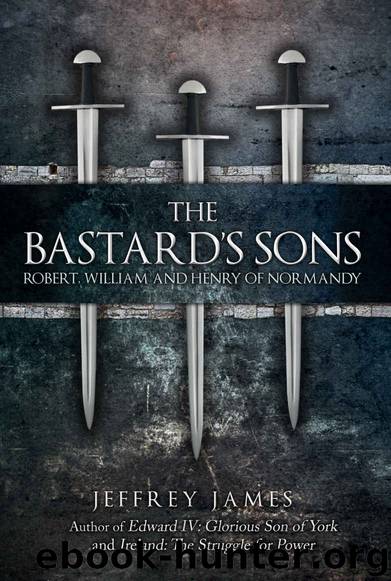The Bastard's Sons: Robert, William and Henry of Normandy by Jeffrey James

Author:Jeffrey James [James, Jeffrey]
Language: eng
Format: epub
Publisher: Amberley Publishing
Published: 2020-03-14T16:00:00+00:00
9
HENRY IN PERIL
During the long winter of 1090/1 Robert Curthose attempted to reassert his authority by placing the castle at Courci-sur-Dive, located in the modern-day Vienne department in the Nouvelle-Aquitaine region of western France, under close siege. Robert’s attack on Courci was in support of claims to ownership made by the recently imprisoned Robert de Bellême. Putting aside any earlier reservations as to Bellême’s loyalty, and perhaps now less ready to take his uncle Odo’s advice with respect to the Montgomery family, the duke now actively sought him out as an ally. Bellême had in fact dutifully fought alongside Henry and other ducal loyalists at Rouen, but he had acted in a self-seeking manner in the aftermath of the fighting by taking men hostage and demanding ransoms. It might seem surprising Bellême could oppose the duke at one moment and be his ally the next. At a distance of almost a millennium it is impossible to know what drove political alignments. Bonds between lord and subject were of course permanent, but long-running vendettas like that between Tosny and Evreux were equally important in swaying loyalties. Another of these long-running feuds existed between Bellême’s family and the Giroie-Grandmesnils – the result of the earlier mentioned killings in the days when William Talvas and William d’Giroie had clashed. In fact, the two clans had been at loggerheads as long anyone could remember, with the dukes of Normandy very much piggies in the middle.
The Grandmesnil family, like the Montgomerys, figure prominently in Orderic Vitalis’ writing. They were the founders of St Evroult monastery, the monk’s home for most of his life. Hugh de Grandmesnil had fought at Hastings and became one of the Conqueror’s most trusted lieutenants. For his service, he had gained shrieval responsibilities in Leicestershire, where he held sixty-seven manors. He had also been allotted land in Nottinghamshire, Hertfordshire, Northamptonshire, Gloucestershire, Warwickshire and Suffolk. Hugh was lucky to survive Hastings. During the battle his bridle broke during one the many cavalry charges that day, leaving him powerless to control his mount, which careered toward the spears of the English. Only when a great shout went up from the enemy did the horse shy away and bolt back in the opposite direction to safety. Hugh’s sons had ridden out with Robert Curthose during the rebellion of 1078–9, earning their father’s disapproval for doing so. A desire to make things right the following year had seen Hugh join others to act as a conciliator between William and Robert. Hugh and one or more of his sons had again supported the duke in 1088 when ravaging royal estates in England.
Robert Curthose joined forces with Bellême at the latter’s siege lines around the Grandmesnil stronghold at Courci-sur-Dive, where a great wooden tower, known as the Belfry, had been built; it could be moved on four wheels and was designed to overlook a castle’s defences and overawe its inhabitants. Robert was helping Bellême target the possession of a family for whom the duke had much to
Download
This site does not store any files on its server. We only index and link to content provided by other sites. Please contact the content providers to delete copyright contents if any and email us, we'll remove relevant links or contents immediately.
| Africa | Asia |
| Canadian | Europe |
| Holocaust | Latin America |
| Middle East | United States |
Fanny Burney by Claire Harman(26526)
Empire of the Sikhs by Patwant Singh(22974)
Out of India by Michael Foss(16791)
Leonardo da Vinci by Walter Isaacson(13181)
Small Great Things by Jodi Picoult(7019)
The Six Wives Of Henry VIII (WOMEN IN HISTORY) by Fraser Antonia(5394)
The Wind in My Hair by Masih Alinejad(5033)
A Higher Loyalty: Truth, Lies, and Leadership by James Comey(4843)
The Lonely City by Olivia Laing(4748)
The Crown by Robert Lacey(4722)
Millionaire: The Philanderer, Gambler, and Duelist Who Invented Modern Finance by Janet Gleeson(4374)
The Iron Duke by The Iron Duke(4291)
Papillon (English) by Henri Charrière(4195)
Sticky Fingers by Joe Hagan(4100)
Joan of Arc by Mary Gordon(4013)
Alive: The Story of the Andes Survivors by Piers Paul Read(3968)
Stalin by Stephen Kotkin(3875)
Aleister Crowley: The Biography by Tobias Churton(3586)
Ants Among Elephants by Sujatha Gidla(3417)
